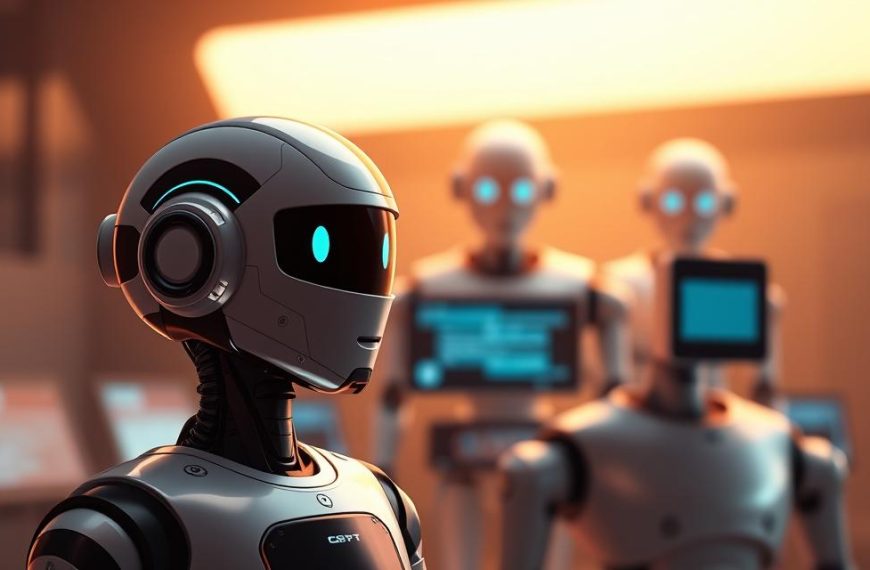Artificial intelligence has revolutionised content creation, blurring lines between human and machine-generated text. Recent research reveals 6% of marketers using AI publish unedited material, raising concerns about authenticity in professional and academic circles. Tools like ChatGPT now produce essays, code, and even legal analyses – but their errors often go unnoticed due to overly confident phrasing.
The sophistication of modern AI models creates unique challenges. While they excel at mimicking human writing patterns, their outputs sometimes contain factual inaccuracies presented with unwarranted certainty. This phenomenon makes distinguishing authentic content crucial for maintaining trust in digital communications.
Educators, employers, and readers increasingly need strategies to verify content origins. Our comprehensive guide addresses this need through practical detection techniques. We analyse linguistic quirks, structural patterns, and contextual awareness gaps that expose chatbot involvement.
Mastering these identification skills helps professionals prioritise transparency while harnessing AI’s efficiency. From spotting repetitive phrasing to recognising unnatural logic flows, our methods equip users to navigate today’s complex content landscape responsibly.
Understanding the Differences Between AI-Generated and Human-Written Content
Modern content creation exists on a spectrum between algorithmic efficiency and human creativity. Large language models analyse existing text to generate new material through statistical pattern recognition rather than conscious thought.
Defining AI-Generated Text
Systems like ChatGPT produce responses by calculating word probabilities across massive datasets. These language models prioritise coherence over factual accuracy, often replicating common phrases without understanding their meaning.
“AI writing resembles a sophisticated collage of existing patterns rather than original thought,” notes Dr. Eleanor Whitmore, Oxford University linguistics researcher.
Characteristics of Human-Written Content
Human authors naturally incorporate:
- Idiomatic expressions shaped by cultural context
- Subtle emotional undertones
- Industry-specific anecdotes
| Trait | AI-Generated | Human-Written |
|---|---|---|
| Creativity | Pattern-based variations | Conceptual innovation |
| Error Patterns | Factual inconsistencies | Typographical slips |
| Cultural References | Generic placements | Context-specific usage |
This distinction becomes crucial when assessing content reliability. While AI excels at producing grammatically correct text, human writing demonstrates intentional stylistic choices rooted in lived experience.
The Importance of Recognising AI-Generated Content
Digital landscapes now face unprecedented challenges as undisclosed AI content infiltrates critical information systems. Over 300 industry experts recently signed an open letter warning about automated systems potentially “flooding our information channels with propaganda”. This development forces users to question the origins of every fact sheet, news article, or research paper they encounter.

Implications for Trust and Credibility
When users can’t verify content sources, trust in digital communications erodes. A 2023 Cambridge study found 42% of readers distrust articles once they suspect AI involvement. The problem intensifies when chatbots present fabricated statistics as facts – a common issue in political commentary and health advice.
Educational institutions face particular scrutiny. One London university reported 19% of submitted essays showed definitive AI patterns last term. “We’re assessing regurgitated information, not student intelligence,” explains Dr. Helena Greaves, ethics lecturer at University College London.
Impact on Academic and Professional Standards
Key sectors face mounting challenges:
- Universities revising plagiarism policies to address AI-generated submissions
- Recruitment teams struggling to assess genuine writing skills
- Media outlets implementing costly verification processes
Creative industries suffer unique pressures. Advertising agencies report clients rejecting “too perfect” copy that lacks human nuance. Meanwhile, legal professionals debate the ethics of using AI-generated briefs containing unverified case references.
“Undetected AI content undermines the very purpose of education and professional accreditation,” states the Open Society Foundation’s digital integrity report.
These developments raise fundamental questions about information authenticity in decision-making processes. From parliamentary briefings to medical research, the stakes for accurate human-authored content have never been higher.
Identifying Common Patterns in AI Writing
AI-generated texts often exhibit distinct structural signatures that careful readers can identify. While these systems produce grammatically sound material, their outputs frequently reveal machine-like tendencies through predictable formatting choices and vocabulary patterns.
Repetitive Phrasing and Structure
Automated content often relies on recycled phrases like “delve deeper” or “navigating complexities” across multiple sections. This repetition stems from language models prioritising word probability over creative variation. Lists and bullet points particularly expose this tendency, with AI frequently restating concepts using near-identical wording.
Structural uniformity appears in predictable paragraph lengths and formulaic transitions. Unlike human writers who vary sentence structures organically, AI tools often create text that follows rigid templates. Technical documents might use three identical sentence patterns consecutively, while marketing copy could repeat emotional adjectives without contextual relevance.
Flat Tone and Absence of Personal Insight
Machine-generated content typically lacks the subjective perspectives that characterise human authorship. While factually coherent, it often reads like encyclopaedia entries rather than informed analysis. This absence of personal insight becomes evident when discussing topics requiring real-world experience or cultural awareness.
“AI-generated reports might list industry trends accurately, but they’ll never share lessons from a failed product launch,” observes digital content strategist Marcus Whitford.
The text often omits region-specific references crucial for UK audiences, such as local regulations or dialect nuances. Human writers naturally incorporate these elements through lived experience, creating content that resonates beyond surface-level information.
How can you tell if something was written by chatbot
Spotting machine-generated content requires careful analysis of both substance and style. Manual verification methods focus on identifying gaps where artificial intelligence struggles to replicate human expertise.

Substance Evaluation Techniques
Authentic content typically demonstrates practical understanding through specific examples. Look for vague statements like “businesses should optimise processes” without concrete implementation strategies. Human writers often reference real-world case studies or regional regulations relevant to UK markets.
Test suspected material by inputting key phrases into chatbot platforms. If similar structures appear across multiple outputs, this indicates formulaic generation. Effective reviews compare suspected text with known human-authored pieces on identical topics.
Linguistic Fingerprints
AI-generated texts frequently exhibit:
- Overly symmetrical paragraph lengths
- Predictable transition phrases like “Furthermore, it’s important to note”
- Absence of British colloquialisms or cultural references
While chatbots produce grammatically flawless sentences, human writing often contains deliberate stylistic variations. Notice texts that repeat ideas using identical wording rather than building arguments progressively.
“The lack of authentic voice remains AI’s greatest limitation. Even advanced models can’t replicate a journalist’s lived experience covering Westminster politics,” observes The Guardian’s digital editor.
Cross-checking technical claims against verified sources provides additional verification. Machine-generated content might cite non-existent studies or misattribute quotes due to training data limitations.
Tools and Techniques for Detecting AI-Generated Text
Identifying machine-authored content requires specialised software that analyses linguistic fingerprints. Modern detection tools combine pattern recognition with contextual analysis to flag suspicious material. These solutions help educators verify student work and enable publishers to maintain editorial standards.
Top AI Detector Tools in the Market
Leading detection platforms offer varying capabilities:
- GPTZero: Free scans up to 50,000 characters with probability scoring
- WRITER: API handles 500,000 words monthly alongside basic checks
- Originality.AI: Combines plagiarism scanning with AI detection for agencies
ZeroGPT supports 125,000-character analyses across 30 languages, while Undetectable AI uniquely offers content humanisation features. Free tiers typically suit individual users, whereas enterprise solutions manage bulk verification.
Evaluating Detector Accuracy and Limitations
Independent tests reveal current detectors achieve 60-84% accuracy. Premium tools outperform free versions, but false positives remain common. A 2024 benchmark showed 68% accuracy for top free software versus 84% for paid equivalents.
“No detector is infallible. Cross-referencing results across multiple platforms reduces misidentification risks,” advises Cambridge University’s Digital Verification Lab.
Educational institutions often combine Originality.AI with manual checks, while publishers prioritise API-integrated solutions. Users should verify critical findings through contextual analysis and source comparison, particularly when assessing legal or medical content.
Assessing Content Style, Clarity and Nuance
Authentic communication thrives on stylistic fingerprints that algorithms struggle to forge. While AI-generated text achieves technical precision, human writing reveals itself through imperfections and personality – the very qualities that build reader connection.

Voice: The Human Advantage
Skilled writers embed their worldview through deliberate language choices. A London restaurant review might reference “proper Sunday roast vibes”, while tech analysis could sarcastically note “another Silicon Valley moonshot”. These cultural touchpoints demonstrate lived experience beyond data patterns.
AI content often defaults to neutral phrasing acceptable across regions. Human authors:
- Use regional idioms naturally
- Inject humour where context allows
- Reveal professional biases through word selection
“Authentic voice contains contradictions – moments of hesitation or passion that algorithms smooth over,” observes The Times’ digital editor.
Structure Tells the Story
Human writing flows with organic rhythm. Paragraph lengths vary based on emotional weight rather than template requirements. Technical explanations might include “Let me break this down” interjections, while opinion pieces use rhetorical questions to engage readers.
| Style Marker | Human | AI |
|---|---|---|
| Cultural references | UK-specific examples | Generic global analogies |
| Sentence structure | Mix of short/long | Consistent mid-length |
| Expertise signals | Niche terminology | Broad dictionary terms |
This stylistic analysis proves particularly effective when assessing UK market content. Human writers reference local regulations like GDPR nuances, while AI often defaults to universal data protection principles.
Spotting Misinformation in ChatGPT-Influenced Responses

AI systems present outdated data as current facts due to fixed knowledge cutoffs. Most language models stop updating their information in mid-2024, creating accuracy gaps in fast-moving fields like technology and healthcare. The Poynter Institute’s verification framework helps users separate reliable data from algorithmic hallucinations.
Knowledge Cutoffs and Their Consequences
ChatGPT responses about post-2024 UK regulations often recycle outdated policies. A 2025 model might discuss pre-Brexit trade agreements as current information. These limitations become critical when assessing:
- Medical guidelines (e.g., NHS protocol updates)
- Financial regulations (FCA rule changes)
- Technological developments (5G rollout stages)
Cross-referencing AI-generated claims against official .gov.uk sources remains essential. For instance, GPT-4 might incorrectly cite Ofcom’s 2023 social media guidelines as applicable to 2025 content moderation disputes.
“Treat AI outputs as preliminary research notes, not verified sources,” advises the Poynter Institute’s digital literacy team.
Verification Protocols for UK Users
Effective fact-checking involves three steps:
- Compare statistics with Office for National Statistics databases
- Validate dates against trusted news archives
- Test technical claims through industry white papers
Recent cases show GPT models confusing Scottish devolution powers with Westminster’s current authority. Such errors highlight the need for source triangulation – particularly when handling legal or governmental information.
Challenges and Limitations in AI Detection
Current verification methods struggle with fundamental technical constraints. Detection tools analyse statistical patterns rather than meaning, creating inherent vulnerabilities. Even advanced systems misclassify content regularly, complicating real-world applications across education and publishing.
False positives and negatives
Mozilla Foundation’s Jesse McCrosky highlights a critical flaw: “Tools label genuine student essays as AI-generated 10% of the time.” Human-written technical manuals often trigger false alarms due to formulaic structures. Conversely, sophisticated chatbots now mimic casual phrasing to bypass detectors.
Educational institutions face ethical dilemmas when using tools with known error rates. A 2024 UK university trial found detection software incorrectly flagged 1 in 8 essays. These limitations force users to treat results as indicators rather than proof.
The evolving arms race
Developers constantly refine both AI tools and detection systems. Each improvement in pattern recognition sparks countermeasures from language model creators. This cycle ensures detectors remain reactive rather than proactive.
McCrosky observes: “The cat-and-mouse game guarantees permanent uncertainty.” New AI models generate personalised writing styles within weeks of release. Detection tools then require complete retraining, creating costly delays for organisations.
Professionals must combine multiple verification methods. Cross-checking suspicious content through plagiarism scanners and manual analysis helps mitigate risks. Always make sure critical decisions incorporate human judgement alongside automated systems.








